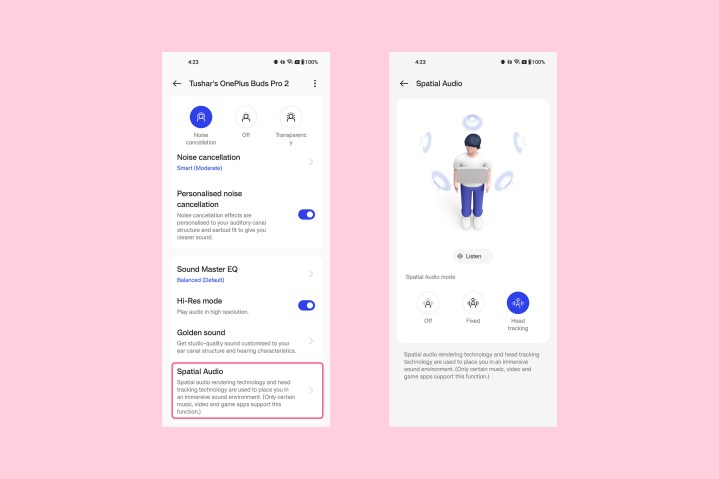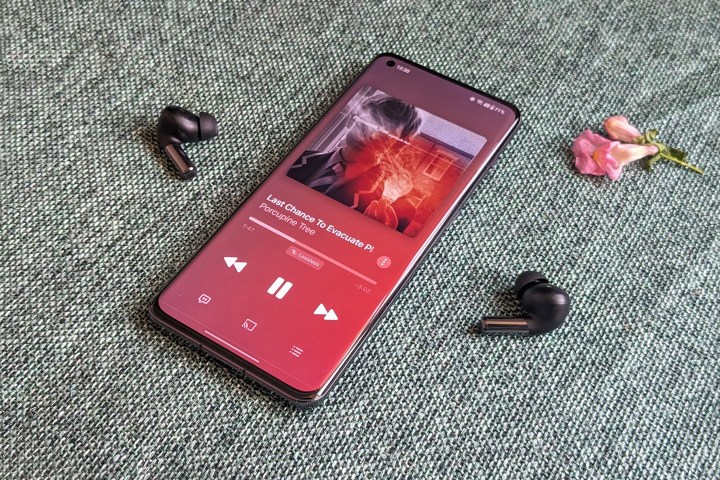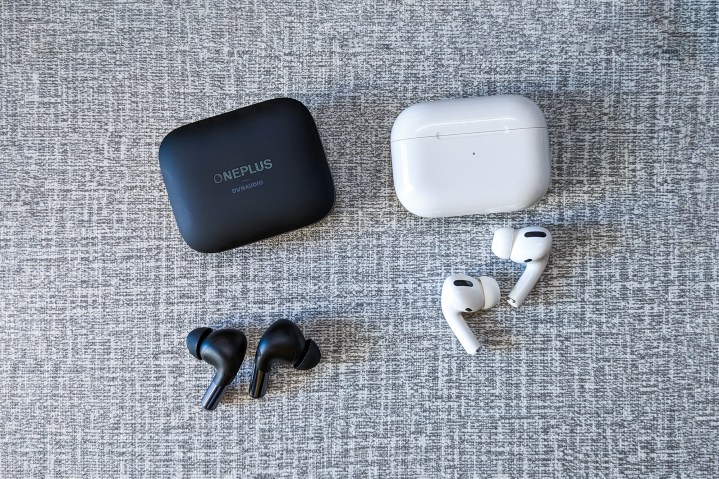The OnePlus Buds Pro 2 Bluetooth earbuds are among a half-dozen gadgets OnePlus launched at its Cloud 11 event. These earbuds intend to elevate your sound experience with a rich and highly customizable audio profile, Google’s Fast Pair support, high-fidelity (Hi-Fi) audio through the LDAC and LHDC Bluetooth audio codecs, Dolby Audio, and noise cancellation.
While these features have essentially been carried over — and slightly improved — over the first generation of the OnePlus Buds Pro launched last year, the Buds Pro 2 are equipped with spatial audio capabilities that help create a realistic and experiential 3D audio space around you. Along with spatial audio, the earbuds also support head tracking to simulate an ambiance that changes as you move your head around.

What is spatial audio?
For over a decade, phone and audio brands have marketed a virtual surround-sound experience, mimicking a more extensive 5.1, 7.1, or 7.2 channel surround-sound setup. In other words, it’s trying to make it sound like there are many more channels than just left-right coming into your head.
Spatial audio is a more advanced version of virtual surround sound and typically creates a virtual 3D space to simulate the exact immersive experience you would get with a physical surround sound setup. Beyond just enveloping you in a virtual space, spatial audio creates an illusion of sound coming from multiple audio sources surrounding you in a broader — and more realistic — radius than the archaic virtual surround sound technology.
Spatial Audio on OnePlus Buds Pro 2 — what sets it apart
According to OnePlus, the Buds Pro 2 are the first pair of Bluetooth earphones to support Android 13’s spatial audio feature. With Android 13, Google introduced APIs for developers to integrate spatial audio and head-tracking support into their apps. These APIs allow spatial audio-related adjustments to be made early on in the audio signal chain to reduce latency. This will allow OnePlus Buds Pro 2 to theoretically be able to spatialize audio in various Android apps — from entertainment apps to short video formats and games.

OnePlus also roped in (as in paid) Hollywood music producer Hans Zimmer to create a special EQ setting for spatial audio. Zimmer has orchestrated the scores for cult favorites such as 1994’s The Lion King, Interstellar, and Christopher Nolan’s Batman trilogy, among many others. The background score for Dune, which has been lauded for highly spellbinding audio, also was composed by Zimmer. One can expect that expertise to steer spatial audio on OnePlus Buds Pro 2 in the right direction. OnePlus says the special spatial audio EQ mode, called “Soundscape,” will be available in the coming weeks for the OnePlus Buds 2 Pro and can be expected to unlock the gates to a theatre-like audio experience on the OnePlus Buds Pro 2.
How the OnePlus Buds Pro 2’s spatial audio compares with the AirPods Pro

Turn on spatial audio for the OnePlus Buds Pro 2 and it starts to sound like the audio is coming from a farther distance. The spatial audio sound signature feels so much more elaborate and nuanced that you’re bound to suspect OnePlus is intentionally degrading the standard stereo output to get more people to use spatial audio. But if you wish to enjoy the enhanced audio output without dwelling on conspiracy theories, the OnePlus Buds Pro 2 are off to a great start.
You can choose between a standard spatial audio setting that simply expands the ambiance virtually and another option for head tracking. As you would expect from the naming, the latter uses your head’s movements and manipulates the audio to seem as if it is fixed in the virtual space. To track actual head movements in a physical space, the OnePlus Buds Pro 2 use a custom inertial measurement unit or IMU sensor, which combines an accelerometer, gyroscope, and magnetometer. In addition, OnePlus claims to refine signals from this sensor with a dedicated spatial audio algorithm.

In reality, the head tracking on the OnePlus Buds 2 Pro is instant and highly accurate. The direction of the sound changes at once without any perceivable latency.
More enticing than the audio quality is, therefore, the spatial audio and head tracking finesse on the OnePlus Buds Pro. Of course, that wouldn’t be the case had the Buds Pro 2 been not so impressive in terms of audio quality themselves. For a detailed analysis of the sound quality of the earbuds and other features, you can read our full OnePlus Buds Pro 2 review.
It also is important to point out the audio output may vastly vary with the quality of the source. OnePlus’s implementation also allows for standard-quality audio content (from apps like YouTube and TikTok) to be upscaled for spatial audio, but that may sometimes mean the audio can sound distorted or seemingly not coming from the front. This is because TikToks are not designed with spatial audio in consideration.
However, if you listen to high-quality music — say, Lossless quality on Apple Music or FLAC files on an offline music player app, the results with head tracking can be astonishing. Besides support from the app and the quality of the media file, this will also depend on how the actual composer intended it to sound and whether the track is optimized for multi-channel surround sound.

Another caveat is that these earbuds only account for head rotation around fixed axes and not for forward or backward movement. So if you’re walking with the feature turned on, you will still feel that the audio landscape is moving with you, which refutes the objective. In contrast, one might argue that walking is not ideal for testing the feature as you might prefer to sit down and enjoy it. In that case, I wish OnePlus either reminded you to switch off head tracking or did that automatically for you.
Spatial audio can especially be a vital addition to movies, TV shows, or other video content with intense background scores. For instance, Netflix supports spatial audio, but you need the 4K subscription plan to enjoy it. Surprisingly, despite having the plan, I cannot feel any noticeable change with head tracking. Perhaps the Buds Pro 2 doesn’t support Netflix yet (or the other way around, as Netflix is known to keep a tight grip on its association with hardware), but I hope to try it out with immersive movies when Zimmer’s special EQ mode comes via an OTA update. I also hope to see audio from more third-party apps not just supported but also optimized for spatial audio on these earbuds.
OnePlus Buds Pro 2 vs. Apple AirPods Pro: Spatial audio and head tracking

To put them to another test of virtue, we pit the OnePlus Buds Pro 2 against the Apple AirPods Pro. While the OnePlus Buds Pro 2 rely on Android 13’s API for upscaling standard content, Apple devices with custom chips — essentially iPhones, iPads, and MacBooks except those with Intel chips — support upscaling any content to spatial audio.
The transition from regular stereo to spatialized audio using the AirPods Pro is much more subtle compared to these OnePlus earbuds. Here you do not feel that stereo audio quality is being suppressed intentionally. However, when head tracking is turned on, the response to physical movements is noticeably slower than OnePlus Buds Pro 2.
Unlike on the OnePlus earbuds, you can actually sense an unignorable delay with head tracking on the AirPods Pro. Thankfully, the adjustment in audio in response to head movements isn’t sudden and, thus, does not sound janky. Like everything Apple, this might be an experiential thing where transitions are intentionally slowed down for smoothness. Or it could owe to the fact that Apple’s Bluetooth audio transmissions are mostly limited to AAC codec (with the exception of ALAC in certain cases), which is qualitatively poorer than LHDC, which the OnePlus Buds Pro 2 support.
Furthermore, the head tracking on Samsung Galaxy Buds 2 Pro is substantially worse — it’s both delayed and janky, making you want to keep it turned off almost always.
Why it matters

Besides the nearly instant adjustment to any head motion, another impressive aspect of the OnePlus Buds Pro 2’s spatial audio is that it is not just limited to its own devices — while Apple limits it to only Apple devices. You can use the HeyMelody app by Oppo (OnePlus’s parent company) to tune and optimize audio, EQ, and other audio enhancement features on any Android phone or tablet. This helps you break free from the walled garden instead of limiting yourself to using just OnePlus (or Oppo) devices.
Unfortunately, spatial audio is currently limited to OnePlus phones at the moment. You can also use the OnePlus Buds Pro 2 with an iOS device, but this combination also lacks spatial audio support.
Overall, the OnePlus Buds Pro 2 can be a suitable gateway device if you want to experience rich and immersive audio without the hassles of spending too much money or assembling an elaborate setup. I would still suggest waiting until the Zimmer EQ mode is added to these earbuds to make a final call about its capabilities while watching movies or TV shows.



